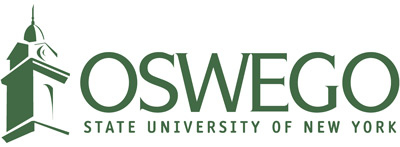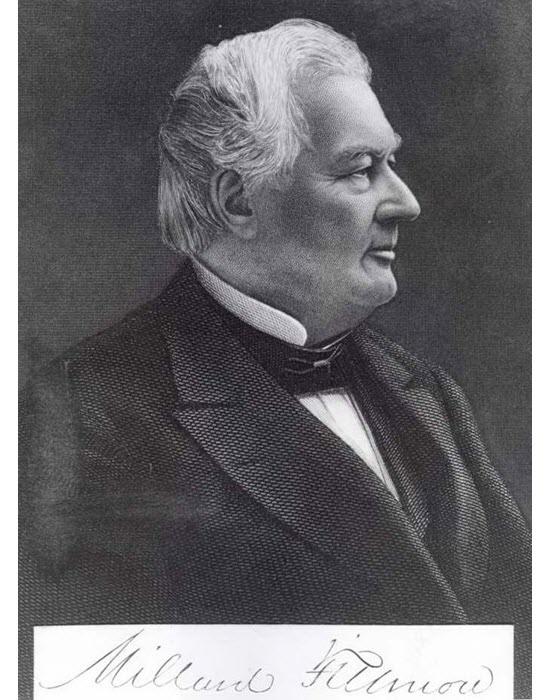Image of U.S. President Millard Fillmore from his presidential papers collection in Penfield Library's Archives and Special Collections.
Penfield Library’s Archives and Special Collections unit has recently completed work on a seven-year project to digitize and provide basic metadata for its collection of U.S. President Millard Fillmore’s papers.
Fillmore was a New York native who became the United States’ 13th president when the president before him, Zachary Taylor, died in office. Fillmore took office in 1850 and served a single term as president during the intense political tensions that led up to the U.S. Civil War.
Penfield’s collection of Fillmore’s papers is now available online on the New York Heritage digital collections website, and includes images of the documents as well as searchable information regarding who various letters were to and from, where the writer was located (if known), and when the letter was written.
The Millard Fillmore Papers Collection includes 40,000 pages of primary source content. According to Digital Collections Librarian Marissa Caico, most of the collection is incoming correspondence, but it also includes financial records, legal documents, speeches, writings and notes, newspaper clippings, ephemera, maps, a passport and miscellaneous other materials. Ephemera are things like rough drafts, to-do lists and concert tickets that were created for practical purposes in day-to-day life, with no expectation that the items would be saved and enter the historical record.
“The materials are not only interesting given the context that they belonged to an ex-president, but because they do an excellent job of capturing everyday life at the time,” Caico said. As a result, you can learn about popular culture at the time, travel, relationships within families, and more.
Of course, you can learn about the politics of that era, too.
“Fillmore is best known for signing the legislation that later became known as the Compromise of 1850,” said Frank Byrne of Oswego's history faculty. Byrne called the pieces of legislation making up the Compromise of 1850 “one of the most significant political deals in American history.” The intent of the Compromise of 1850 was to address tensions between free states and slave states at that time. In the end, however, parts of the compromise itself ended up creating controversy –- particularly the Fugitive Slave Act, Byrne said.
This collection of Fillmore’s papers “provides scholars insight into the political machinations that went into… the 1850 Compromise,” Byrne said. “Furthermore, the collection helps us better understand the social, cultural and economic issues that shaped antebellum America.” Primary documents like these are essential to historical research, and any U.S. president is an important player when someone wants to understand what was going on in that era, he noted.
“I think about how much I learned about Millard Fillmore and his social circle and the things that I don’t think I’d done before this project," said University Archivist Librarian Zachary Vickery, who worked on the project. "I visited the Fillmore family gravesite in Buffalo. I held in my hands letters from President Zachary Taylor, Dorothea Dix, Horace Greely and William Seward. I talked with students about Millard Fillmore more than I thought I would and especially how he impacted the history of our state and our country.”
Context of interactions
As Vickery noted, Fillmore’s newly digitized correspondence includes letters from many notable figures of his day. There are letters from social reformer Dorothea Dix, former president William Henry Harrison, influential politicians Henry Clay and Daniel Webster, political activist Anna Ella Carroll, and many other movers and shakers of Fillmore’s era.
There are letters from everyday people as well.
“My favorite letters are those that we’d categorize as ‘hate mail’ today, some sent anonymously, airing grievances about Fillmore’s performance as president and continuing political stances,” Caico said. “It’s cool to think about sitting down to write a strongly worded letter to the president at this time and it’s even more interesting that Fillmore kept them.”
For example, one 1865 letter in the collection, sent after President Lincoln’s death, calls Fillmore “you miserable traitor” and says, “Such men as you have murdered our president.” That letter, which is signed, “from a Citizen and Soldier,” shows Fillmore’s continuing relevance even more than a decade after his term as president had ended.
For years, Fillmore’s papers were lost to scholars, believed to have burned at the request of his son. Instead, the papers passed through a series of owners and were mixed in with other families’ papers along the way. The collection resurfaced in the late 1960s when Lillian A. Wells willed her New Haven property in Oswego County to SUNY Oswego with the papers inside. Fillmore’s papers were moved to Penfield Library’s Archives and Special Collections, where they have resided ever since.
During their years as part of Archives and Special Collections’ physical holdings, the Millard Fillmore Papers have attracted researchers to SUNY Oswego in order to visit them. A relatively recent example is Thomas and Dorothy Hoobler, two scholars who visited the collection in order to gather materials for their 2024 book "Are You Prepared for the Storm of Love Making?: Letters of Love and Lust from the White House."
Now that the papers have been digitized, they will be available 24/7 to students in their residence halls or researchers around the world, with no visit to Archives and Special Collections required.
“Digitized collections are a boon to scholars as they allow for easier access to critical material,” Byrne said. “At a time when it is increasingly more difficult for individuals to afford research travel, digital collections make it possible to continue to study important historical subjects.”
-- Submitted by Penfield Library




